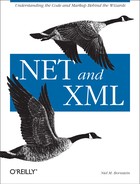A Brief Introduction to the DOM Specification
The DOM architecture is divided into several modules. Although there is no real meaning to the term, a module of the DOM can be thought of simply as a group of related functionality. The modules as defined by the W3C DOM Working Group are:
- DOM Core
DOM Core defines the actual tree-like object model you can use to navigate an XML document.
- DOM XML
The XML DOM extends the DOM Core to deal with XML 1.0-specific features and requirements, such as entities, processing instructions, and character data sections.
- DOM HTML
The HTML DOM extends the DOM Core to deal with HTML-specific requirements. These include the ability to identify a particular link in an HTML document.
- DOM Events
This module enables you to access the DOM tree through mouse, keyboard, and HTML-specific events.
- DOM Cascading Style Sheets
DOM CSS allows you to manipulate the formatting of documents through Cascading Style Sheets (CSS), as well as manipulating the style sheets themselves. For information on CSS, see Cascading Style Sheets: The Definitive Guide, by Eric A. Meyer (O’Reilly).
- DOM Load and Save
Loading and saving documents is an integral part of XML work, and this is the part of the DOM that allows you to do so.
- Document Editing
This module includes methods for manipulating a DOM tree while still maintaining its validity.
- DOM XPath
DOM XPath includes a set of functions for querying a DOM tree using XPath 1.0 expressions. Although we will use some XPath features in this chapter, XPath is discussed in detail in Chapter 6.
In addition, the DOM Working Group has defined several
levels of functionality. The requirements for
each level are formally documented by the W3C at http://www.w3.org/DOM/DOMTR.
Tip
HTML DOM is also sometimes referred to as DOM Level 0, although a DOM Level 0 is formally described in the DOM Level 1 documents.
- Level 1
DOM Level 1 specifies the DOM Core and HTML DOM modules. The recommendation itself, like all the DOM recommendations, includes IDL (Interface Definition Language) definitions and Java and ECMAScript bindings. The DOM Level 1 Core specification includes such things as the actual tree structure, memory management, and naming conventions. The Level 1 HTML DOM includes naming conventions and HTML-specific elements.
- Level 2
DOM Level 2 includes recommendations for DOM Core, Views, Events, Style, Traversal and Range, and HTML (still in progress as of this writing). The changes in DOM Level 2 Core include new types and changes to interfaces and exceptions, and the IDL version has been made more up-to-date.
- Level 3
DOM Level 3 includes more changes to DOM Core and Events, as well as new Load and Save and XPath recommendations. As of this writing, all of the DOM Level 3 recommendations are still in the Working Draft stage, so there is no support for Level 3 in the .NET Framework.
- Other Levels
The future holds any number of additional levels. Anything that you see in the list of DOM modules that is not listed in Levels 1 through 3 is fair game for some future level. Stay tuned to
http://www.w3.org/DOM/for the latest news about DOM.
